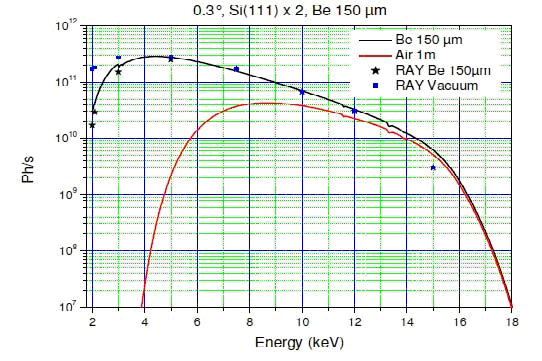Joint Research Group Ultrafast Dynamics
Characterization of the beamline
Parameter of the x-ray beamline:
General beamline parameters:
| Photon Energy range | 2keV -14 keV |
| Photon Flux | 1011 photons/s (monochromatic) |
| Energy resolution | 1/1000 -1/5000 |
| x-ray pulse duration | 100 ps (hybrid mode), >10 ps (low-α mode) |
| x-ray spot size | 150 µm |
Source characteristics: :
| Electron Energy | 1.7 GeV |
| Magnetic Field | 1.3 T |
| Bending Radius | 4.35 m |
| Power (0.3 A, 3 x 0.41 mrad2) | 50 W |
| Source Size σx, σy | 0.158 mm, 0.04 mm |
| Source Divergence σx, σy | 388 µrad, 21 µrad |
The beamline is designed for resonant and non-resonant x-ray diffraction experiments and for Extended X-ray Absorption Fine Structure spectroscopy and x-ray Absorption Near Edge Spectroscopy ( (EXAFS, XANES) experiments. In combination with an ultrafast laser, a temporal resolution of the duration of the x-ray probe pulse (~100 ps in hybrid mode, ~ 10ps in low-α mode) can be achieved. The beamline is equipped with a collimating parabolic mirror M1 and a refocusing parabolic mirror M2. Both mirrors are fabricated from Silicon substrates. Further mirror parameters are:
Mirror coating Rh 50 Å + Pt 600 Å, surface roughness < 3Å, grazing incidence angle 0.3 deg
| M1 | M2 | |
| Size | 1200 x 60 mm | 1200 x 60 mm |
| Distance to source | 16890 mm | 7000 mm (to focal point) |
The beamline provides two operational modes: monochromatic beam (option 1) and white beam (option 2)
Option 1: The white collimated beam passes a double crystal monochromator DCM, which covers an energy range from 2.1 keV to 18 keV. It consist of two Si(111) crystals and provides an energy resolution of 1/1000 up to 1/5000.
Option 2: By taking the monochromator crystals of the beam path the focussed white beam can enter the experimental hutch. In this configuration the focal point is 25 mm lower compared to option 1.
Detectors:
- For time-resolved experiments we employ a fast photomultipliers (PMT, Hamamatsu).in combination with fast plastic scintillators (rise time < 0.5 ns) The electrical output of the PMT is optionally amplified with a low-noise current amplifier (FEMTO) and fed into a time correlated single-photon-counting module (TCSPC, PicoHarp 300, Fa. PicoQuant). In combination with ultrafast detecors, the TCSPC-module has a temporal resolution of 4 ps. Typically we choose a channel width of 20 ps and cover a temporal interval of 4.6 µs.
- several energy dispersive detectors (Amptek, Roentec) are available They were successfully used for energy resolving white beam diffraction techniques or reflectometry.
Diffractometer:
A θ -2θ diffractometer (Fa. Huber) is presently available. (resolution Δθ min= 0.001 deg) In near future a new 4-circle diffractometer will be installed . It allows time-resolved diffraction experiments in symmetric and asymmetric Bragg geometries.
Cryostat The future setup will additionally support diffraction experiments at low temperature. It provides a cryostat that enables sample cooling down to approximately 20 K.


